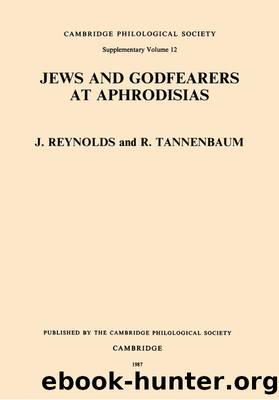Jews and Godfearers at Aphrodisias by J. Reynolds R. F. Tannenbaum

Author:J. Reynolds, R. F. Tannenbaum [J. Reynolds, R. F. Tannenbaum]
Language: eng
Format: epub
Tags: History, Ancient, Greece, Jewish, Civilization
ISBN: 9781913701185
Google: LbYzEAAAQBAJ
Publisher: Cambridge Philological Society
Published: 2020-08-30T03:37:13+00:00
IVHISTORICAL SIGNIFICANCE
What does this inscription tell us that is of importance to the history of Judaism?
In studying this text, we have found that reasonable interpretations of terms that seemed impenetrably obscure in the Greek would emerge on confronting them with the terminology of the standard rabbinical sources. We have therefore felt encouraged to make a more extensive use of such sources to interpret a diaspora document than is usual in Jewish-Greek epigraphy. The case for doing so is that it works: a consistent and, we hope, reasonable interpretation has come out of it. We point this out not by way of methodological advice: the problems posed by this particular stone turned out to require this particular method; for other stones this may not be so. But there are historical deductions to be drawn from the fact that this method works for this stone.
It would appear that, by the early third century at least, there is greater institutional parallelism between the Greco-Roman diaspora and Palestine than has hitherto been thought: the diaspora does not go its own independent way. As the Pseudepigrapha indicate, some at least of the Jews of the western diaspora are free to invent their own stoicizing/Platonizing interpretatio Graeca of Biblical theology. The authors of the Constitutiones Apostolicae, a fourth-century Christian work, appear to have borrowed several chapters (7.33â7)1 from a lost Jewish-Greek prayer-book of (apparently) the second century A.D., which took a stoicizing view of Godâs nature and functions. A prayer-book may reasonably be thought to have been intended for liturgical use: ch. 39 reproduces the scheme of the Qedusha preserved in the present synagogue liturgy, which is believed to go back to the second century A.D.2 This raises the possibility that a stoicizing version of Jewish theology appeared in at least some synagogue prayer-books in the Greek-speaking diaspora. In that case, the philosophical Judaism we know from the Pseudepigrapha could represent the creed of an unknown proportion of the communities in the western diaspora, and not just the opinions of hellenizing intellectuals.
Our new epigraphic evidence from Aphrodisias suggests that the western diaspora is, however, more or less at one with Palestine, by the late second to early third centuries, as to the requirements of the Law. To what degree? In some details the conformation is exact: for others we do not know, and will try to guess. The parallelism between ÏάÏελλα and ת×××× (tamḥui), for one, seems precise. The other possible parallels are less compelling. There are too many possible Hebrew translations of δεκανία for us to be sure what the word means: it might be a translation of a specifically rabbinical term, but it might also be a common Greek word for a society. As an association the decany could be an old diaspora institution and not a rabbinical novelty. On the other hand, Ïιλομαθεá¿Ï, like other such words in Jewish Greek inscriptions, may translate the rabbinic talmidei ḥakhamim (âdisciples of the sagesâ), but need not necessarily do so (Philo, who shows relatively little Pharisaic influence, uses it extensively).
Download
This site does not store any files on its server. We only index and link to content provided by other sites. Please contact the content providers to delete copyright contents if any and email us, we'll remove relevant links or contents immediately.
The Daily Stoic by Holiday Ryan & Hanselman Stephen(3235)
The Fate of Rome: Climate, Disease, and the End of an Empire (The Princeton History of the Ancient World) by Kyle Harper(3003)
People of the Earth: An Introduction to World Prehistory by Dr. Brian Fagan & Nadia Durrani(2701)
Ancient Worlds by Michael Scott(2626)
Babylon's Ark by Lawrence Anthony(2620)
The Daily Stoic by Ryan Holiday & Stephen Hanselman(2461)
Foreign Devils on the Silk Road: The Search for the Lost Treasures of Central Asia by Peter Hopkirk(2434)
India's Ancient Past by R.S. Sharma(2416)
MOSES THE EGYPTIAN by Jan Assmann(2373)
The Complete Dead Sea Scrolls in English (7th Edition) (Penguin Classics) by Geza Vermes(2235)
Lost Technologies of Ancient Egypt by Christopher Dunn(2194)
The Earth Chronicles Handbook by Zecharia Sitchin(2180)
24 Hours in Ancient Rome by Philip Matyszak(2050)
Alexander the Great by Philip Freeman(2033)
Aztec by Gary Jennings(1975)
The Nine Waves of Creation by Carl Johan Calleman(1884)
Curse Tablets and Binding Spells from the Ancient World by Gager John G.;(1838)
Before Atlantis by Frank Joseph(1811)
Earthmare: The Lost Book of Wars by Cergat(1790)
